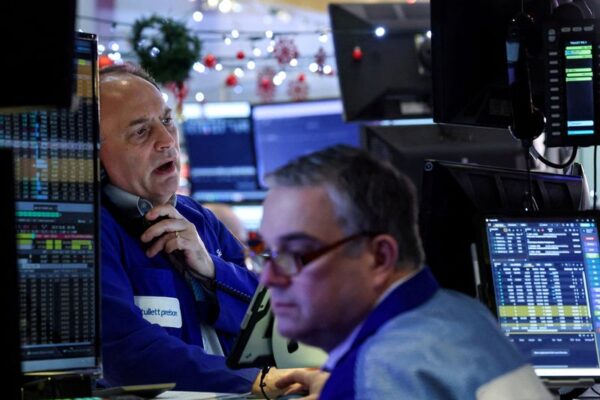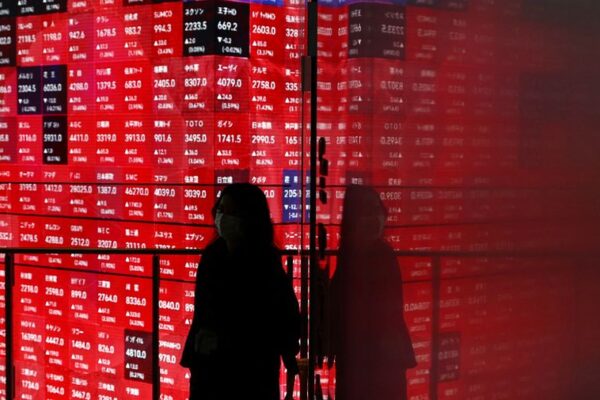After sizzling rebound, investors weigh whether stocks have more bounce
By Lewis Krauskopf
NEW YORK (Reuters) – Wall Street stormed back this week after absorbing a long-awaited rate hike from the Federal Reserve, leaving investors to determine whether stocks are set for a sustained rebound or more turbulence.
Following a months-long drubbing, the S&P 500 delivered its best weekly gain since November 2020 as investors cheered increased clarity on monetary policy and an encouraging assessment of the U.S. economy from the Fed. The surge cut the index’s year-to-date losses by nearly half, though it is still down 6.7% for 2022 after falling into a correction last month.
Whether to hop on board the rally is a thorny question in a market that still faces its share of risks – chief among them the hawkish rate hike path the Fed unveiled on Wednesday and geopolitical uncertainty over Russia’s invasion of Ukraine.
Still, some big banks believe the worst may be over, for now. Strategists at UBS Global Wealth Management on Friday said the projected pace of Fed tightening is “consistent with rising stocks” and advised clients to remain invested in equities.
JPMorgan (NYSE:JPM) earlier in the week forecast the S&P 500 would end the year at 4,900, about 10% above Friday’s close, saying that markets “have now cleared the much-anticipated Fed liftoff with policy likely as hawkish as it gets.”
Others are less sanguine. Worries that the Fed’s fight against inflation could bruise growth were apparent in the bond market, where a flattening of the yield curve accelerated after the Fed’s policy meeting this week. An inverted yield curve, in which yields of shorter-term government bonds rise above those of longer-term ones, has been a reliable predictor of past recessions.
Stubborn inflation, sky-high commodity prices and few signs of an end to the war in Ukraine further cloud the picture for investors, said Rick Meckler, a partner at Cherry Lane Investments.
“The markets are more complicated now by interest rates, they are more complicated by inflation, and they are definitely more complicated by the Russian situation,” he said. “You had a lot of people in this week who thought we made a bottom, but it’s difficult to keep having higher and higher prices just based on that.”
Many also believe the week’s sharp gains in stocks are unlikely to quiet the economic concerns that fanned bearish sentiment in recent months.
Fund managers’ allocation to cash stand at their highest levels since April 2020, according to BofA Global Research’s monthly survey. Bearish sentiment among retail investors is close to 50%, the latest survey from the American Association of Individual Investors showed, well above the historic average of 30.5%.
“The thing we are most concerned about right now … is really a question of whether we are going to go into a recession or not,” said King Lip, chief strategist at BakerAvenue Asset Management.
Wary of a potential “stagflationary” environment of slowing growth and rising inflation, Lip’s firm is investing in energy shares, commodities and precious metals such as gold ETFs or gold-mining stocks.
Cresset Capital Management is recommending that clients underweight equities and raise their exposure to gold, which is viewed as a safe-haven asset, said Jack Ablin, Cresset’s chief investment officer.
“We see certainly a pretty aggressive Fed that has really made inflation-fighting its number one priority and not necessarily protecting equity market values,” Ablin said.
To be sure, signs of rampant pessimism – such as high cash levels and dour sentiment — are often seen as contrarian indicators that are positive for equities. Indeed, hedge funds tracked by BoFA Global Research were recently piling into cyclical stocks, which tend to thrive when economic growth is strong.
“Despite weakening optimism on global growth, clients do not appear to be positioning for a recession,” BoFA’s strategists wrote.
Stocks historically have weathered rate-hike cycles fairly well. Since 1983, the S&P 500 has returned an average of 5.3% in the six months following the first Fed rate rise of a cycle, data from UBS showed.
“The Fed’s goal remains to engineer a soft landing for the economy,” the firm’s analysts wrote. “We advise investors to prepare for higher rates while remaining engaged with equity markets.”












 Bitcoin
Bitcoin  Ethereum
Ethereum  Tether
Tether  XRP
XRP  USDC
USDC  Solana
Solana  TRON
TRON  Lido Staked Ether
Lido Staked Ether  Dogecoin
Dogecoin